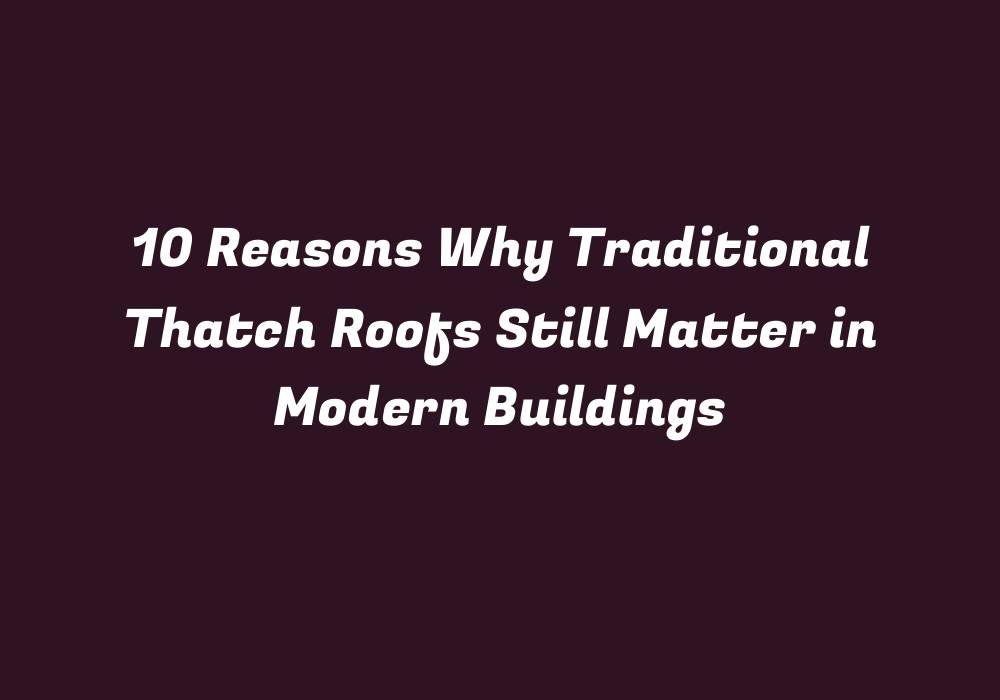10 Reasons Why Traditional Thatch Roofs Still Matter in Modern Buildings
In a world where modern architecture is rapidly evolving, it’s essential to consider the value of traditional elements in contemporary buildings. One such element is the use of thatch roofs, which have been in existence for thousands of years and are still prevalent today. Let us explore ten reasons why these remarkable structures continue to matter even amidst the fast-paced development of modern architecture.
1. Energy Efficiency
One of the primary advantages of traditional thatch roofs is their energy efficiency. These roofs are typically constructed with natural materials like grasses, reeds, and straw. The air spaces within these materials help regulate temperatures, reducing cooling costs in warmer climates. In colder regions, they provide insulation against heat loss. This makes thatched roofs an ideal choice for homes, particularly in remote locations or areas where electricity is not readily available.
2. Environmental Friendliness
Thatch roofs have a minimal environmental impact, making them a sustainable option for modern architecture. Their construction requires the use of locally sourced, renewable materials that do not deplete resources like oil and other non-renewables. Furthermore, they are easily recycled at the end of their lifespan, ensuring they remain part of the circular economy. This eco-friendly approach aligns with contemporary architectural trends focused on sustainable design practices.
3. Aesthetic Appeal
The beauty and charm of traditional thatch roofs are undeniable. They add a unique aesthetic appeal to any building, bringing an element of timelessness and character unmatched by modern materials like asphalt shingles or metal roofs. The intricate patterns created by the weaving of thatching materials result in a distinctive, eye-catching design that enhances architectural value.
4. Fire Resistance
In areas prone to wildfires, traditional thatch roofs can provide added protection. The organic nature of these roofs allows them to burn less intensely than synthetic materials like fiberglass and plastic. Consequently, they offer a higher degree of fire resistance, which is essential for structures situated in high-risk fire zones.
5. Thermal Comfort
As mentioned earlier, thatched roofs’ natural insulation properties help regulate temperatures within the building. They provide warmth and comfort in colder climates while also preventing overheating during warmer periods. This contributes to a healthier indoor environment for occupants, ultimately improving their overall well-being.
6. Sound Insulation
Another advantage of thatch roofs is their ability to absorb sound and reduce noise pollution. The porous nature of these roofs helps create a softer acoustic environment, making them an ideal option for residential and commercial buildings in urban settings. This characteristic makes them particularly appealing for homes situated near busy streets or noisy neighbors.
7. Durability
Traditional thatch roofs have a proven track record of lasting up to 100 years, depending on the maintenance and care provided. Although they require periodic replacement of certain materials, this investment in longevity makes them an appealing choice for architects and homeowners concerned with long-term costs. Moreover, regular maintenance helps maintain the roof’s structural integrity, ensuring it continues to provide essential functions for decades to come.
8. Cultural Heritage
Thatch roofs are a significant aspect of many cultures and traditions around the world. They have been incorporated into historical buildings and continue to serve as a symbol of identity in numerous communities. By incorporating these timeless designs into modern architecture, developers can preserve and celebrate local heritage while creating architectural landmarks that reflect their regional roots.
9. Affordability
One of the most notable aspects of thatch roofs is their relatively low cost in comparison to modern materials like metal or asphalt shingles. This affordability makes them an attractive option for homeowners and architects looking to build sustainable, eco-friendly structures on a budget. It also allows for more flexibility in allocating resources for other aspects of the project, resulting in a greater overall value for the building.
10. Human Factor
Perhaps one of the most important reasons why traditional thatch roofs still matter is their human connection. Working with these materials can foster a sense of pride and involvement among local craftspeople who have been passing on the art of thatching from generation to generation. By integrating these practices into modern architecture, communities can preserve their cultural heritage and promote skills crucial for maintaining traditional craftsmanship.
In conclusion, traditional thatch roofs offer numerous advantages in terms of energy efficiency, environmental friendliness, aesthetics, fire resistance, thermal comfort, sound insulation, durability, affordability, cultural significance, and the human factor. Incorporating these unique structures into modern architecture demonstrates a commitment to sustainability and preservation, ultimately elevating the value and appeal of contemporary buildings.
